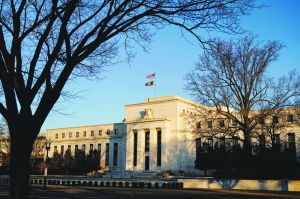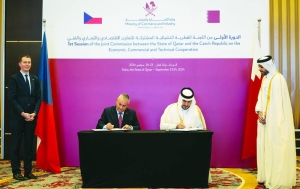Fed seen signalling September rate cut at next week’s meeting


The Federal Reserve building in Washington. The Fed is likely to signal next week its plans to cut interest rates in September, according to economists surveyed by Bloomberg News, a move they say will kick off reductions each quarter through 2025.
Nearly three-quarters of respondents say the US central bank will use the July 30-31 gathering to set the stage for a quarter-point cut at the following meeting in September. They’re divided, however, about how policymakers will do so.
Half of respondents see officials signalling the upcoming move with both the policy statement and Fed Chair Jerome Powell’s press conference 30 minutes later, but others anticipate the Fed to use one method or the other. All respondents expect the Fed to keep rates unchanged at a more than two-decade high at next week’s meeting.
The survey of 47 economists was conducted July 22-24, following President Joe Biden’s withdrawal from the presidential election.
In recent weeks, Fed officials led by Powell have said the labour market has come into balance and inflation has resumed falling towards the central bank’s 2% target, suggesting they see a growing case for lowering borrowing costs. They are now putting emphasis on the central bank’s goal of maximum employment as well as stable prices when deciding on policy.
“I do believe we are getting closer to the time when a cut in the policy rate is warranted,” Fed Governor Christopher Waller said last week. Chicago Fed President Austan Goolsbee warned that monetary policy has become increasingly restrictive with inflation falling, while “the economy’s not overheating.”
Nearly two-thirds of Fed watchers expect the Federal Open Market Committee to say in the post-meeting statement that officials have gained some additional confidence inflation is moving to its target — a step toward cutting.
More than a quarter of economists, however, see no signalling of rate adjustments at the July meeting. Instead, the message could be firmed up in the weeks that follow, including during the chair’s annual speech in Jackson Hole, Wyoming in late August.
The economists’ median view for interest-rate cuts in September and December is slightly less aggressive than markets, which put better than even odds of 75 basis points of cuts this year. Some investors are even betting on an initial half-point cut, but economists see the odds of that as an unlikely 20%.
Such a move would likely be spurred only if labour market conditions, now viewed as strong but less overheated, were seen deteriorating.
While the unemployment rate remains relatively low at 4.1%, it has now edged higher in each of the last three months. It’s up from a low of 3.4% in early 2023, raising some concerns about recession risk. The July jobs report will be released next week.
“The labour market has been cooling for a while — the deterioration isn’t sudden. Given its dual mandate, the Fed is likely behind the curve on cutting rates. As such, we expect the unemployment rate to reach 4.5% by the end of 2024,” says Anna Wong, chief US economist at Bloomberg.
One complication for September would be its proximity to the US presidential election in November. An initiation of rate cuts less than two months before the election would likely be subject to criticism about political motivations.
A third of economists say that would raise the bar for cuts, meaning the data would need to be incrementally more compelling, though the rest say they agree with Powell’s view that the timing of the election would have no impact on a decision about borrowing costs.
While the presidential election, as well as competition for control of Congress, has brought uncertainty over the outcome for US fiscal policy in 2025, economists say the decision by Biden to withdraw from the race hasn’t changed their economic outlook. An overwhelming majority say they haven’t altered forecasts for interest rates or growth because of the president’s decision.
Still, one third of Fed watchers say political uncertainty stemming from the election this year has raised downside risks to growth. Changes in tax policies and spending would affect the 2025 economy, and potentially interest rates.
“If the federal deficit worsens in 2025, monetary policy will have to tighten and growth will decelerate,” said Thomas Fullerton, an economics professor at the University of Texas at El Paso and one of the survey respondents.





